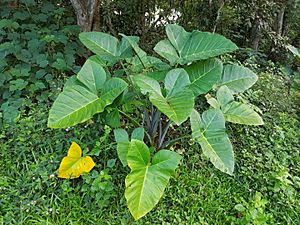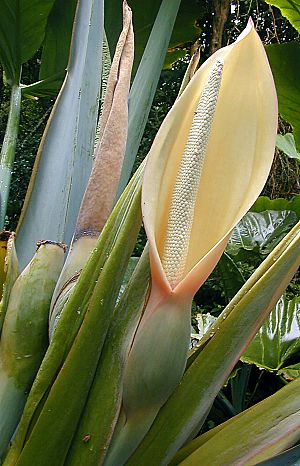Xanthosoma sagittifolium facts for kids
Xanthosoma sagittifolium, often called the arrowleaf elephant ear or malanga, is a tropical plant known for its large, arrow-shaped leaves. It grows an edible, starchy part underground called a corm, which is similar to a potato. Some types of this plant have purple stems or leaves and are called things like blue taro or purple elephant's ear. It's important to know that Xanthosoma sagittifolium is different from true taro, which belongs to another plant group called Colocasia.
Quick facts for kids Xanthosoma sagittifolium |
|
|---|---|
 |
|
| Xanthosoma sagittifolium in Bukidnon, Philippines | |
 |
|
| Xanthosoma sagittifolium inflorescence | |
| Scientific classification | |
| Genus: |
Xanthosoma
|
| Species: |
sagittifolium
|
| Synonyms | |
|
|
Contents
How People Use Arrowleaf Elephant Ear
This plant is very popular in many countries, especially for its edible parts.
Different Names Around the World
People in different places have their own names for Xanthosoma sagittifolium.
- In Bolivia, it's called walusa.
- In Colombia, it's known as bore.
- In Costa Rica, you might hear tiquizque or macal.
- In Cuba, it's called malanga.
- In Mexico, it's known as mafafa.
- In Nicaragua, it's quequisque.
- In Panama, it's called otoe.
- In Venezuela, it's known as ocumo.
- In Brazil, the leaves are sold as taioba.
The underground corm, also called nampi or malanga, is used in cooking in all these countries. Sometimes, this plant is grown in areas where new trees are being planted. It helps control weeds and gives shade to the young trees.
Cooking with Yautía in the Caribbean
In Puerto Rican cuisine and Dominican cuisine, the plant and its corm are called yautía. It's a very important ingredient in many dishes.
- In Puerto Rican pasteles, yautía is ground up with other ingredients like squash, potatoes, green bananas, and plantains. This mix forms a paste that is filled with pork or ham. It is then wrapped in a banana leaf or paper and boiled.
- The yautía corm is often used in stews and soups. You can also simply boil it and serve it like a potato.
- It's used in local dishes such as guanime, alcapurrias, sancocho, and mondongo.
- For alcapurrias, yautía is ground with green bananas to make fried croquettes. These croquettes are usually filled with seasoned ground meat (picadillo) or seafood.
- Yautía majada is a mashed version of the corm, similar to mashed potatoes.
- Yautía puree is often served with fish or shellfish that has been cooked in coconut milk.
Tayer in Suriname and the Netherlands
In Suriname and the Netherlands, this plant is known as tayer.
- A popular Surinamese dish called pom uses the shredded root. It's baked with chicken, fruit juices, salted meat, and spices.
- Pom is often eaten over rice or on bread. It's a common dish at family gatherings and special events in Suriname and is also very popular in the Netherlands.
- In Surinamese cooking, the leaves are often baked with a Maggi-cube (a chicken broth cube). They are then eaten with rice and chicken or salted beef.
See also
 In Spanish: Xanthosoma sagittifolium para niños
In Spanish: Xanthosoma sagittifolium para niños

